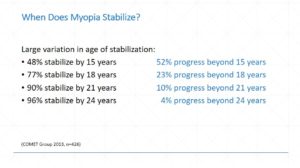November 1, 2021
By Dwight Akerman, OD, MBA, FAAO, FBCLA
Parents often ask myopia management clinicians, “How long will my child require myopia management treatment?” or “When will my myopic child stop progressing so treatment can end?” Unfortunately, there is not a straightforward answer.
The NEI-funded COMET Trial (2013) demonstrated that myopia often stabilizes by age 18, but not always, especially in today’s myopigenic world. At baseline, the COMET cohort included 469 ethnically diverse American children aged 6 to younger than 12 years with spherical equivalent refractive error between -1.25 and -4.50D in each eye, no more than 1.50D of astigmatism, and less than 1.00D of anisometropia (spherical equivalent). Data were analyzed on 426 of the original cohort following at least seven refraction measurements over 11 years. The following chart summarizes important data gathered from this landmark study.
The overall goal of myopia management is to stop the progression of both axial length and spherical equivalent Rx. From a macro standpoint, the goal is to ensure the patient’s axial length is less than 26 mm and the spherical equivalent Rx (SERx) is less than -6.00D. (Tideman et al., 2016) Myopia clinicians can consider tapering then potentially stopping treatment when the SERx progression is less than -0.25D per year, and axial length progression is less than 0.10 mm per year. (Klaver et al. 2020)
Further discussion about this critical topic can be found in two excellent papers published in Review of Myopia Management during 2021. Rebecca Weng, BOptom (Hons), Grad Dip (I&T), MBA, from BHVI wrote in her article When and How Should Myopia Management Treatment Be Stopped? that the decision to discontinue myopia treatment requires as much consideration as treatment initiation. Erin Tomiyama, OD, MS, and Kathryn Richdale, OD, PhD, wrote in their article Graduating Patients From Myopia Management that the ultimate choice of when to stop must be based on an educated discussion with the patient and parent.
Best professional regards,

Dwight H. Akerman, OD, MBA, FAAO, FBCLA
Chief Medical Editor
dwight.akerman@gmail.com














